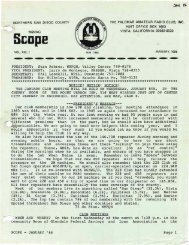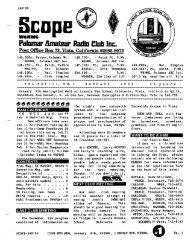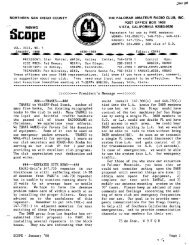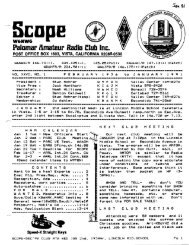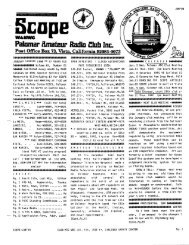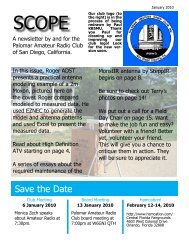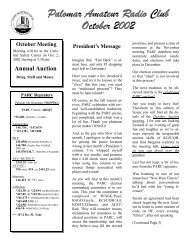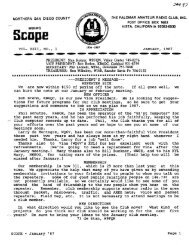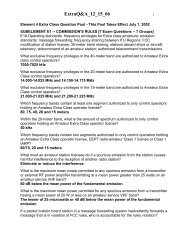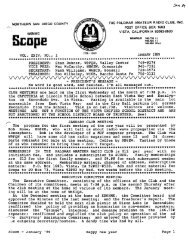You also want an ePaper? Increase the reach of your titles
YUMPU automatically turns print PDFs into web optimized ePapers that Google loves.
copying costs. Printer is to be donated to a [!J salary as leader ofthe expedition was wooden trestles in the world. The<br />
student in north county. NashlW6HCD<br />
940-1028 Fallbrook<br />
Kenwood TS-50<br />
The Field Day crew needs to borrow<br />
a TS-50 DC cord to use on Field Day. If<br />
you have such a cord, please contact<br />
NN3Vor KE6ZLY.<br />
Selective GPS<br />
The recent decision to turn off the<br />
selective availability feature of the<br />
Global Positioning System should provide<br />
better accuracy for users of GPS<br />
units. This change is good news for<br />
boaters, hikers, private pilots and others<br />
for whom accurate navigation is a serious<br />
concern.<br />
Most ofyou already know that a GPS<br />
unit can provide infonnation on your<br />
elevation or altitude although in the past<br />
this data hasn't been particularly accurate.<br />
Today we have relatively easy access<br />
to technology like PC's, HT's, cell<br />
phones, the Internet, and highly accurate<br />
test and measurement devices for almost<br />
every imaginable need. With all these<br />
tools at our disposal we perhaps tend to<br />
be a bit technologically chauvinistic towards<br />
earlier generations who did things<br />
somewhat differently.<br />
As mentioned above, your GPS unit,<br />
supported by an incredible multi-billion<br />
dollar system of satellites can now be<br />
used to measure the altitude of your<br />
favorite mountain topping site with even<br />
greater accuracy. But how was this done<br />
by those living in the mid 1800's and how<br />
good were they at using what was then<br />
state-of- the-art technology?<br />
On August 13, 1843, John Charles<br />
Fremont's second expedition reached<br />
South Pass on the Oregon Trail in what<br />
is now the state of Wyoming. Fremont<br />
recognized the importance ofthis pass to<br />
future western expansion therefore a series<br />
of barometric readings were taken to<br />
determine its elevation for mapping purposes.<br />
The elevation of South Pass was<br />
measured as 7,490 feet by using the best<br />
barometers available which cost about<br />
$25 each. By comparison Fremont's<br />
$4 per day plus 10 cents a mile.<br />
An alternate method of measuring<br />
elevation was to measure the boiling<br />
point of water to determine barometric<br />
pressure and thus elevation. Fremont's<br />
party used for this purpose a thermometer<br />
graduated in tenths of a degree<br />
Fahrenheit. This method also would be<br />
capable ofan accuracy ofabout 65 feet.<br />
Using present day technology, the<br />
height of South Pass has been measured<br />
as 7,550 feet. This is an elevation difference<br />
of 60 feet or only 0.8 per cent<br />
from that obtained by Fremont in 1843!<br />
Fremont's men and others on later<br />
surveys were highly competent workers<br />
deserving ofour respect and admiration.<br />
They knew how to exploit the available<br />
technology to the utmost in the field<br />
under what were often very adverse<br />
conditions. 73, Ed KF6DXX<br />
Ham Classes<br />
New <strong>Amateur</strong> <strong>Radio</strong> licensing<br />
classes are starting in July at the Vista<br />
Center for the Blind All classes are held<br />
on Tuesday and Wednesday from 0830<br />
AM until 1200 noon. Technician, General<br />
and Extra will be held.<br />
All students will be required to learn<br />
the Morse alphabet. Call Larry!<br />
WA6UTQ before coming as class size<br />
is limited. 760-758-5820<br />
Train Ride<br />
The train ride on the San Diego and<br />
Arizona RR was really wonderful. I<br />
have been wanting to take this trip for<br />
almost 50 years, every since I was a boy<br />
ofl6 or so.<br />
Some of you who have not been on<br />
the San Diego Hiker reflector for long<br />
or have not been listening to the Friday<br />
evening biking net may not know what<br />
trip I am telJing ofso I will explain.<br />
The trip was on part ofthe line ofthe<br />
old San Diego and Arizona RR<br />
Sys.running from San Diego to EI Centro.<br />
The section I was on was from<br />
Ocotillo to the Goat Canyon Trestle<br />
which is said to be the longest curved<br />
railroad trestle and one of the highest<br />
SD&A RR was built in 1907 to 1912<br />
and the Goat Canyon Trestle was finished<br />
in 1933 as part ofa realignment ot<br />
the original route. The spectacular Goat<br />
Canyon Trestle is 185 ft high and 600 ft<br />
long. As you walk out to the middle and<br />
look down it looks like a lot more than<br />
185 feet down and a lot longer than 600<br />
feet.<br />
The trip I took was sponsored by the<br />
ANZA-BORREGO FOUNDATION.<br />
We started where the tracks cross the<br />
main street of Ocotillo and ended up<br />
about one half mile from the Goat<br />
Canyon Trestle. We had to walk the<br />
last half mile to the Trestle because a<br />
land slide had blocked tunnel #16.<br />
There are 21 tunnels and 17 are in<br />
the Carrizo Gorge.<br />
I call this trip a train ride even<br />
though the vehicles did not look like<br />
what we think of as a train. Some of<br />
them were hooked together to form a<br />
train with a little trailer on behind and<br />
according to Noah Webster you don't<br />
have to have a locomotive for it to be a<br />
train, just a series of cars hooked together.<br />
The little cars that were hooked<br />
together they called speeders and would<br />
haul 6 or so people each. They each<br />
had a Ford four cylinder industrial engine<br />
to power them. They had a roof<br />
but no sides on them. There were 3 of<br />
these hooked together and I rode in the<br />
middle one. The engine was not being<br />
used in the one I was in, it was just<br />
going along for the ride like me.<br />
The only other vehicle was a vintage<br />
railbus built in 1932 built by the same<br />
company that built the speeders. It had<br />
a Ford Model A engine and transmission<br />
and had been beautifully restored<br />
to like new condition. At each end of t<br />
he trip it had to be turned around. They<br />
did this by a portapower jack mounted<br />
under the bus at the ballance point.<br />
They would jack it up about 3 inches<br />
off the track and two people on each<br />
end would spin it around and then they<br />
would let it down on the track.<br />
The trip was about 20 miles each<br />
way and took about 1 hour each way<br />
and we had an hour at the trestle to look



